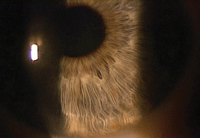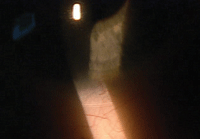 Contact lenses offer a remarkable opportunity for our patients to be free of spectacles and see just as well, if not better. However, no great invention is without its challenges. We are often confronted by patients with contact lens intolerance issues due to a number of factors, including poor compliance, inadequate surface wettability and limitations in lens design.1,2 Underlying ocular surface disease may also play a factor in degrading the quality of the wearing experience through increased lens awareness.
Contact lenses offer a remarkable opportunity for our patients to be free of spectacles and see just as well, if not better. However, no great invention is without its challenges. We are often confronted by patients with contact lens intolerance issues due to a number of factors, including poor compliance, inadequate surface wettability and limitations in lens design.1,2 Underlying ocular surface disease may also play a factor in degrading the quality of the wearing experience through increased lens awareness.
At times, we struggle to meet the visual needs of our patients. Although we have a number of lens options available today, including torics and multifocals, we still occasionally run into situations where contact lenses are not addressing the patient’s visual concerns or the fit doesn’t seem to be optimal. Surprisingly, these same patients may have appeared to be good candidates on paper based on refraction, ocular anatomy, ocular surface physiology and expectations, but somehow––optically––the experience falls short of expectations.
The Missing Link?

1. A prism ballasted lens on the patient’s right eye without any astigmatic correction. Note the small marker at the 6 o’clock position.
When patients for whom we had expected success fail to achieve acceptable vision in the suggested lenses, we may need to consider that binocular issues may be hindering the ultimate visual potential. Although we tend to measure vertical phorias either during the refraction or with other specialized equipment during the exam, very rarely do we take these findings into consideration with contact lens wearers. In fact, most times, we try to avoid these issues by simply attempting to fit contact lenses without consideration for the phoria and instead wait to observe the patient’s response.
Certainly, some patients may benefit from vision therapy––in particular those with significant horizontal phorias secondary to convergence insufficiency. Vertical phorias respond remarkably well to the introduction of a vertical prism, so that the base is oriented in the opposite direction of the phoria deviation.3 If the patient has a right hyperphoria, the introduction of base down prism may alleviate some of the subjective visual symptoms the patient is noticing. Consequently, this allows the eye to assume its natural posture without the need to compensate and attempt to vertically align with the other eye. If this could be done with a contact lens, it may alleviate the problem.
Prism in a Contact Lens
Fortunately, we have a soft toric lens design that features a base down prism through a ballast system. The prism ballast is used to stabilize the lens for the toric prescription. But, can we leverage this technology to help those patients who require vertical prism?
While it would seem feasible to introduce this prism in a contact lens, in order for the patient to appreciate it, there would have to be a difference in the prism magnitude between the right and left eye. Additionally, there would have to be adequate movement of the eye behind the contact lens to align with the new image position altered by the prism.

2. The lens over the left eye contains no prism ballast, as evidenced by no markings on the lens inferiorly.
Knowing this, we should be able to treat a patient who requires low amounts of vertical prism through a prism ballast. Keep in mind, there are certainly limitations to the amount of prism that can be delivered to the eye; usually 1.75 prism diopters is the maximum amount of prism ballast used in a specialty soft contact lens. Also, only base down prism can be delivered through a contact lens, which means introducing the prism ballast on the eye with the hyperphoria.
As the following case illustrates, sometimes providing unique visual correction options ultimately will provide your patients with the best clinical outcomes.
A Case Study
A 55-year-old white female presented to our office for a comprehensive examination. At that time, her chief complaint was decreased near vision with her current multifocal contact lenses. Her best-corrected visual acuity measured 20/20 O.D. with a +1.25 -0.25D x 010 manifest refraction, and 20/20 O.S. with a +1.25 -0.50D x 105 manifest refraction and a +2.00D add. Binocular status was remarkable for a small hyperphoria O.D. of 2.00 prism diopters, measured through Von Graefe technique. When the prism was demonstrated to her in free space over her best-corrected distance vision in a trial frame, she preferred the vision without any vertical prism. Anterior and posterior segment health was normal.
She was fit with a center near aspheric simultaneous multifocal contact lens design. She did well at the initial fitting and follow-up visit, and continued wearing the lenses. Approximately six months later, she came back to the office with a complaint of decreased distance vision. A trial lens spherical over-refraction was performed in free space, and there were no lenses that improved her vision. When a 1.00 prism diopter base down lens was placed in front of the right eye, the patient responded subjectively with improved vision. However, when a 2.00 prism diopters base down lens was placed in front of the right eye it blurred her vision.
Through a specialty lens laboratory (Unilens), we ordered the patient a near center aspheric multifocal trial lens with +1.25D distance prescription and a +1.75D add O.U. Even though the patient didn’t have any astigmatism, the right lens was created with a prism ballast of 1.25 prism diopters in an attempt to deliver base down prism. The patient was dispensed the lenses and the initial visual response was overwhelmingly positive.
In an attempt to determine whether the intended prismatic power was being delivered to the right eye, a one prism diopter base down loose lens was held over the right eye first and then the left eye. When held over either eye, it made the vision blurrier than without the lens, which confirmed that the prism ballast was delivering sufficient prism.
A little over a week later, the patient was seen for follow-up and noted that the vision (both distance and near) was “great” through the new lenses. Although the right lens was not a toric, added prism ballast delivered the required vertical prism for the patient.
Most specialty soft contact lens manufacturers would likely be able to create a lens with a prism ballast.
The take-home message from this case: When all else fails, thinking outside of the box can deliver an improved wearing experience and successfully keep patients in their lenses.
1. Dumbleton KA, Woods CA, Jones LW, Fonn D. The relationship between compliance with lens replacement and contact lens-related problems in silicone hydrogel wearers. Cont Lens Anterior Eye. 2011 Oct;34(5):216-22.
2. Epstein A, Stone R. Surface and polymer chemistry: the quest for comfort. Rev Cornea Contact Lens. 2010 Jan/Feb;247(1):15-9.
3. O’Leary CI, Evans BJ. Criteria for prescribing optometric interventions: literature review and practitioner survey. Ophthalmic Physiol Opt. 2003 Sep;23(5):429-39.


